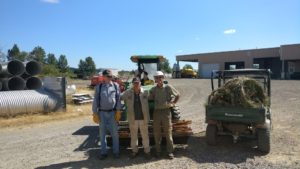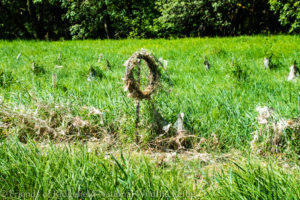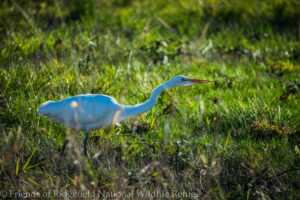I started here in mid-January 2017. In fact, I started closer to the end of January due to quite a few days of weather closures. Snow! On one of my very first days on the job I watched a coyote nimbly trot through snow on the River ‘S’ Unit.
By the spring, Gee Creek was so high the term “creek” was an aspersion. You could say the rains dampened our restoration efforts. This was in  stark contrast to our summer efforts, where for weeks the only rain we may have received came in the form of ash from nearby wildfires. Only when fall came did we feel any sense of normalcy, except, by December it stopped raining again! It was gloriously sunny during the day, and by night we got a short spell of a brilliant super moon.
stark contrast to our summer efforts, where for weeks the only rain we may have received came in the form of ash from nearby wildfires. Only when fall came did we feel any sense of normalcy, except, by December it stopped raining again! It was gloriously sunny during the day, and by night we got a short spell of a brilliant super moon.
The weather completely disregards restoration efforts. But the wildlife does not. The deer eat our red osier dogwoods as if they were licorice. The beavers eat our trees if we are careless with our cages. The egrets, however, are apathetic.
Promising untrammeled wilderness for the enjoyment of present and future generations, many folks conjure wild images of Yellowstone or Yosemite when thinking of public lands. If the National Park system is “America’s best idea” then the National Refuge system is America’s best notion. In not only working at a National Wildlife Refuge, but living on one too, I am in the unique position to see that National Wildlife Refuges are both heavily influenced by the hand of man, and beautifully wild. These units are not neat. They are hewn from heavy machinery, grazing, traipsing, diking, and channelizing.
In the span of a year, I and many of the wonderful volunteers I interacted with nearly every day, got our hands very, very dirty. We struggled to  make cages around small willows nice, roomy, and beaver-proof. We hacked at gargantuan blackberry canes growing in ash trees. We walked in neat rows with tall rubber boots on through the wetlands looking for bulrush plants. Our orange handled hori horis have become iconic to Auto Tour Route drivers. We conquered a few miles worth of barbed wire fencing. We planted camas bulbs. We nearly cut a new trail. We took day trips to other regional refuges.
make cages around small willows nice, roomy, and beaver-proof. We hacked at gargantuan blackberry canes growing in ash trees. We walked in neat rows with tall rubber boots on through the wetlands looking for bulrush plants. Our orange handled hori horis have become iconic to Auto Tour Route drivers. We conquered a few miles worth of barbed wire fencing. We planted camas bulbs. We nearly cut a new trail. We took day trips to other regional refuges.
In February, during the pre-dawn hours, we pretended to be Columbian white-tailed deer, while the Refuge learned how best to remote tally us. We waded waist deep in frigid wetlands in April looking for Oregon spotted frog egg masses. We paddled ponds adjacent the Gorge, handling stinky canned sardines, trapping and collecting pond turtles in July. In November, we made our way to a National Fish Hatchery where we played a key role in the creation of the next generation of Chinook salmon.
Come and trammel with us! Because you put on seven pounds over the holidays. Because we are so close to your house, you can drive here in under an hour. Because your New Year’s resolution is to do something. Because you love owls. Because you’ve never been here before. Because you need a distraction. Because you need to get out of the house. Because you need community service hours. Because you want some comradery. Because!
Every ounce of effort put into refuges is to construct amusement parks for wildlife like geese and deer. Sometimes, the wildlife that refuges protect are explicitly protected by the Endangered Species Act. But sometimes, like coyotes in the snow, wildlife benefit because a thriving  keystone species portends the ultimate in trickle-down economics. Because if geese and deer eat well, so too do coyotes, herons, otters, sharp-shinned hawks, osprey, bald eagles, garter snakes, beavers, possum, and, regardless of their indifference, egrets.
keystone species portends the ultimate in trickle-down economics. Because if geese and deer eat well, so too do coyotes, herons, otters, sharp-shinned hawks, osprey, bald eagles, garter snakes, beavers, possum, and, regardless of their indifference, egrets.
-Sean Davis, Habitat Restoration and Education Specialist